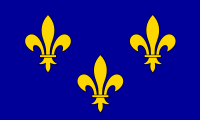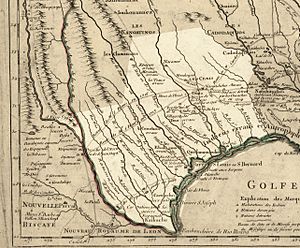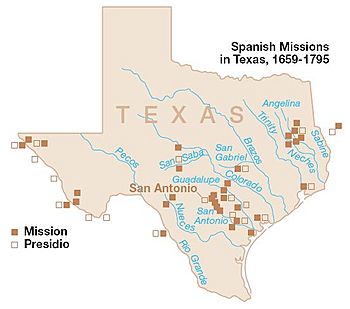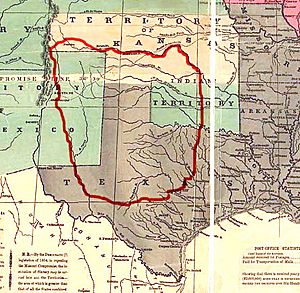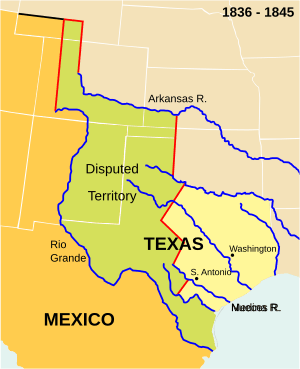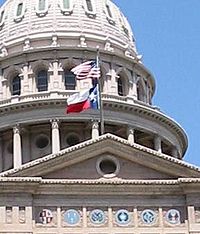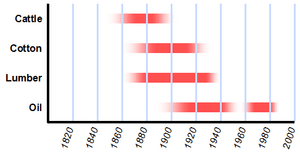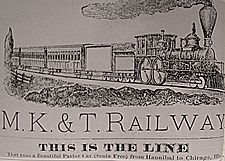History of Texas facts for kids
The story of Texas began long ago. The first Spanish explorers arrived in 1519. They found many Native American tribes living there. The name Texas comes from táyshaʼ, a Caddoan word meaning "friends" or "allies." Native Americans lived in Texas over 10,000 years ago.
From 1519 to 1848, five countries claimed parts of Texas. These were France, Spain, Mexico, the Republic of Texas, and the United States. During the American Civil War, the Confederacy also claimed it.
The first European base was set up in 1680 near modern El Paso. This was by Spanish settlers and Native Americans fleeing a revolt. In 1682, a French explorer named René-Robert Cavelier, Sieur de La Salle, started a French colony called Fort Saint Louis. It was near Matagorda Bay. Native Americans destroyed this colony after three years. This made Spain want to build more settlements to protect their land claims.
Spain set up several missions in East Texas. They were later abandoned. Twenty years later, Spain tried again to colonize Texas. They worried about the French in nearby Louisiana. Over the next 110 years, Spain built many villages, forts (presidios), and missions. Few Spanish settlers came, mostly missionaries and soldiers.
When Mexico won its independence from Spain in 1821, Texas became part of Mexico. Mexico encouraged people from the United States to move there. By 1834, over 30,000 Americans lived in Texas, compared to 7,800 Mexicans.
Mexican and American Texans began to want a revolution. This was due to issues like not having fair courts and the government becoming more military-focused. A fight in Gonzales started the Texas Revolution in 1835. Texan forces fought and won the war by 1836.
Texas declared itself an independent nation, the Republic of Texas. Many immigrants came from the U.S. and Germany, attracted by rich lands for farming and ranching. In 1845, Texas joined the United States, becoming the 28th state. Mexico finally recognized Texas's independence after the Mexican-American War ended in 1848.
Texas left the United States in 1861 to join the Confederate States of America. Few battles of the American Civil War happened in Texas. Most Texas soldiers fought in the east. After the war, enslaved African Americans were freed. Texas then went through a period called Reconstruction. Later, white Democrats took control. They passed laws that created a system of segregation called "Jim Crow." Black people were stopped from voting until the mid-1960s.
In early Texas, the economy relied on cotton, ranching, and farming. Railroads built after 1870 helped new cities grow away from rivers. Timber also became important. In 1901, oil was found at Spindletop Hill. This was the most productive oil well ever seen. This "Texas Oil Boom" changed and enriched Texas's economy forever. After World War II, Texas became more focused on services. Segregation ended in the 1960s. Politically, Texas changed from being mostly Democratic to mostly Republican by the 1970s. Texas's population grew fast in the 20th century. It became the second-largest state in 1994. The state's economy also became very diverse, with new technologies growing in the 21st century.
Contents
- Ancient History of Texas's First People
- Early Spanish Explorers in Texas
- French Colony in Texas: 1684–1689
- Spanish Texas: 1690–1821
- West Texas: The Comanche Empire
- Mexican Texas: 1821–1836
- Republic of Texas: 1836–1845
- Statehood, War, and Growth: 1845–1860
- Confederate Texas and Reconstruction: 1860–1876
- Late 19th Century Texas (1876-1899)
- Texas in the 20th Century: Prosperity, Depression, and War (1900-1945)
- Texas Modernizes: 1945–Present
- Images for kids
- See also
Ancient History of Texas's First People
Texas is where two big Native American cultures met: the Southwestern and the Plains areas. We know about three main groups from old ruins before Europeans arrived:
- The Pueblo people from the upper Rio Grande region.
- The Mound Builders of the Mississippi culture. The Caddo nation are their descendants.
- Civilizations from Mesoamerica, south of Texas.
Very early people, called Paleo-Indians, lived in Texas between 9200 and 6000 BC. They might be linked to the Clovis and Folsom cultures. These nomadic people hunted mammoths and bison using spear-throwers. They got flint from quarries in the Texas panhandle.
Around 4000 BC, more people lived in Texas. This was despite a changing climate and the extinction of giant animals. Many ancient drawings on cave walls and rocks can still be seen today.
Native Americans in East Texas started settling in villages around 500 BC. They farmed and built the first burial mounds. They were influenced by the Mississippi culture. In the Trans-Pecos area, people were influenced by the Mogollon culture.
Around the 8th century, the bow and arrow appeared in Texas. Pottery making also grew. Native Americans started to rely more on bison for food. Obsidian objects found in Texas show trade with cultures in Mexico and the Rocky Mountains.
No single culture ruled all of Texas. Many different groups lived there. In more recent history, tribes like the Alabama, Apache, Caddo, Comanche, and Tonkawa lived in Texas. The name Texas comes from the Caddoan word táyshaʼ, meaning "friends" or "allies."
Native Americans decided the fate of European explorers. Friendly tribes taught them how to grow crops and hunt. Warlike tribes made life dangerous with attacks. Many Native Americans died from new diseases brought by Europeans. In the 19th century, they fought against European and American expansion. After the American Civil War, the U.S. Army fought to stop their resistance.
Today, three Native American tribes are officially recognized in Texas. They are the Alabama-Coushatta Tribes, the Kickapoo Traditional Tribe, and the Ysleta Del Sur Pueblo.
Early Spanish Explorers in Texas
The first European to see Texas was Alonso Álvarez de Pineda in 1520. He was on an expedition for the governor of Jamaica. He was looking for a passage between the Gulf of Mexico and Asia. Álvarez de Pineda made the first map of the northern Gulf Coast. This map is the oldest record of Texas history.
Between 1528 and 1535, four survivors of an expedition, including Álvar Núñez Cabeza de Vaca, spent years in Texas. They were slaves and traders among different native groups. Cabeza de Vaca was the first European to explore the inside of Texas.
French Colony in Texas: 1684–1689
Even though Spain claimed Texas, they mostly ignored it for over 160 years. The first European settlement happened by accident. In 1682, a French nobleman, René-Robert Cavelier, Sieur de La Salle, claimed the entire Mississippi River Valley for France. The next year, he convinced King Louis XIV of France to start a colony near the Mississippi. This would split Spanish Florida from New Spain.
La Salle's expedition left France in July 1684. They soon lost one supply ship to Spanish privateers. Bad maps and La Salle's mistakes led them to Matagorda Bay in early 1685. This was 400 miles (640 km) west of the Mississippi. In February, the colonists built Fort Saint Louis.
After the fort was built, one ship went back to France. The other two were destroyed in storms, leaving the settlers stranded. La Salle and his men searched for the Mississippi River by land. They traveled as far west as the Rio Grande and east to the Trinity River. Sickness and hardship destroyed the colony. By early 1687, fewer than 45 people were left. That month, La Salle was ambushed and killed in East Texas.
Spain learned of the French colony in late 1685. They saw it as a threat to their mines and shipping routes. The King of Spain's war council wanted to remove "this thorn." Spain sent ten expeditions over three years to find La Salle. The last one found a French deserter living with the Coahuiltecans.
The Frenchman led the Spanish to the French fort in April 1689. The fort and houses were in ruins. Months before, the Karankawa tribe had attacked the settlement. They were angry that the French had taken their canoes without paying. Only four children were spared.
Spanish Texas: 1690–1821
Building the Spanish Colony
News of the French fort's destruction made people in Mexico City hopeful. Spain had learned a lot about Texas geography during their search for Fort Saint Louis. In March 1690, Alonso De León led an expedition to build a mission in East Texas. Mission San Francisco de los Tejas was finished in May near the Hasinai village. Its first Catholic mass was held on June 1.
On January 23, 1691, Spain named Domingo Terán de los Ríos as the first governor of Texas. When he visited Mission San Francisco in August, he found that priests had built a second mission. But they were not having much luck converting the natives. The Indians often stole mission cattle and horses. They showed little respect to the priests. When Terán left Texas, most missionaries went with him. Only 3 religious people and 9 soldiers stayed. A smallpox epidemic was also left behind. The Caddo tribe threatened the remaining Spaniards. They soon left the missions and returned to Coahuila. For the next 20 years, Spain ignored Texas again.
In 1711, a missionary named Francisco Hidalgo asked the French governor of Louisiana for help. This worried Spanish officials. They ordered Texas to be reoccupied. It would be a buffer between New Spain and French settlements. In 1716, four missions and a fort were built in East Texas. The first recorded female settlers in Spanish Texas came with the soldiers.
The new missions were over 400 miles (640 km) from the nearest Spanish town. The governor of Texas, Martín de Alarcón, wanted a stopover point. This would be between the Rio Grande settlements and the East Texas missions. In April 1718, Alarcón led 72 people, including 10 families, into Texas. They settled along the San Antonio River. Within a week, they built Mission San Antonio de Valero and a fort. They also started the town of San Antonio de Béxar, now San Antonio.
The next year, Spain and France went to war. French soldiers from Natchitoches took control of Mission San Miguel de los Adaes. The Spanish colonists, missionaries, and soldiers fled to San Antonio.
The new governor, the Marquis de San Miguel de Aguayo, drove the French out. He ordered a new Spanish fort, Nuestra Señora del Pilar de Los Adaes. It was near present-day Robeline, Louisiana. This new fort became the first capital of Texas. It had 6 cannons and 100 soldiers. The six East Texas missions were reopened. Another mission and fort were built at Matagorda Bay.
Challenges with Native Americans
In the late 1720s, the Spanish government closed the fort in East Texas. They reduced the number of soldiers at other forts. Only 144 soldiers were left in the whole province. Without protection, the East Texas missions moved to San Antonio.
Missionaries could not convert the Hasinai tribe. But they became friends with them. The Hasinai were enemies of the Lipan Apache. The Apache then became enemies of Spain. They started raiding San Antonio and other Spanish areas. A peace was made with the Apache in 1749. A mission was built for them along the San Saba River. The Apache avoided the mission. But this made the Apache's enemies, like the Comanche, angry. They destroyed the mission.
In 1762, France gave up its claim to Texas. They gave all of Louisiana west of the Mississippi River to Spain. Spain no longer needed settlements near French outposts. They ordered Los Adaes to close. San Antonio became the new capital. The people of Los Adaes moved in 1773. After trying to settle elsewhere, they returned to East Texas. They founded Nacogdoches without permission.
The Comanche agreed to a peace treaty in 1785. They were willing to fight Spain's enemies. They soon attacked the Karankawa. Over several years, the Comanche killed many Karankawa. They drove others into Mexico.
In January 1790, the Comanche helped Spain fight the Mescalero and Lipan Apaches. The Apaches were defeated. Most raids stopped. By the end of the 18th century, few hunting tribes in Texas had not become Christian. In 1793, Mission San Antonio de Valero was secularized. The other four San Antonio missions were partly secularized the next year.
Changes and New Borders
In 1799, Spain gave Louisiana back to France. The next year, Napoleon sold Louisiana to the United States. The borders of Louisiana were not clear. The United States said its purchase included most of West Florida and all of Texas. Spain said Louisiana only went as far as Natchitoches. Texas became a buffer area between New Spain and the United States. This argument lasted until 1819. Spain gave Florida to the United States. In return, Spain got clear control of Texas.
During this time, Mexico was also changing. In 1808, Napoleon made the Spanish king step down. Revolutionaries in Mexico and the United States tried to make Texas and Mexico independent. Spanish troops reacted harshly. They looted the province and executed Texans accused of supporting the revolution. By 1820, fewer than 2,000 Hispanic citizens were left in Texas. The situation became normal in 1821. Mexico became independent from Spain. Texas became part of the new nation without a fight.
Spanish Legacy
Spanish rule in Texas was followed by Mexican rule. It is hard to separate their influences. The most obvious legacy is the language. Every major river in Texas, except the Red River, has a Spanish name. So do 42 of the state's 254 counties. Many towns also have Spanish names.
Another clear legacy is Roman Catholicism. At the end of Spain's rule, almost everyone in Texas was Catholic. Many people in Texas still practice Catholicism today. The Spanish missions in San Antonio, built to convert Indians, have been restored. They are now a National Historic Landmark.
The Spanish brought European animals like cattle, horses, and mules to Texas in the 1690s. These animals ate a lot of native grasses. This allowed mesquite, a plant from the lower Texas coast, to spread inland. Spanish farmers also brought plowing and irrigation to the land.
Texas later adopted much of the American legal system. But some Spanish legal practices stayed. These include homestead exemption, community property, and adoption.
West Texas: The Comanche Empire
From the 1750s to the 1850s, the Comanche were the most powerful group in the Southwest. Their land was called Comancheria. They faced Spanish, Mexican, and American outposts. The Comanche worked to increase their safety and power. Their population was 7,000 to 8,000 from 1810 to 1830.
The Comanche used their military strength to get supplies and workers. They did this by raiding, looting, and kidnapping. There was much violence by and against the Comanche. They also hunted, especially buffalo. The Comanche empire also had a trade network. They spread their language and culture across the region. The Comanche bands were mostly independent but allied.
Their empire fell when diseases like smallpox and cholera hit their camps in the late 1840s. They also fought bloody conflicts with settlers, the Texas Rangers, and the U.S. Army. Their population dropped from 20,000 to a few thousand by the 1870s. The Comanche could no longer fight the U.S. Army. The U.S. Army took control after the Mexican-American War ended in 1848.
Mexican Texas: 1821–1836
In 1821, Mexico won its independence from Spain. Texas became part of the new country of Mexico. The Mexican Constitution of 1824 joined Texas with Coahuila to form the state of Coahuila y Tejas. The government said Texas could form its own state later.
Mexico passed a law that let all heads of household claim land. Mexico did not have enough people or money to protect settlers from Comanche raids. They hoped more settlers would help control the raids. So, they allowed people from the United States to move to Texas.
The first land grant was given to Moses Austin under Spanish rule. His son, Stephen F. Austin, took over. His settlers, called the Old Three Hundred, settled along the Brazos River in 1822. The Mexican government approved this grant. Twenty-three other land agents brought settlers to Texas, mostly from the United States.
Many American settlers owned slaves. Mexico outlawed slavery in 1829. But Texas got a one-year exception. Then, the Mexican president ordered all slaves freed in 1830. To get around this, colonists made their slaves "indentured servants for life." By 1836, there were 5,000 enslaved African Americans in Texas.
In 1830, Mexico outlawed immigration from the United States to Texas. New forts were built to watch immigration and customs. New laws also required customs duties. This angered both native Mexican citizens (Tejanos) and Americans. In 1832, a group of men revolted against customs enforcement in Anahuac. Texans sided with federalists against the government. After a battle, they drove all Mexican soldiers out of East Texas.
Texans wanted more political freedom. This led to the Convention of 1832. They demanded that U.S. citizens be allowed to immigrate. They also asked for Texas to become its own state. The next year, Texans repeated their demands. Stephen F. Austin, who delivered their petition, was jailed for two years in Mexico City. Mexico tried to calm the colonists. But Antonio Lopez de Santa Anna changed Mexico from a federalist to a centralist state. This gave Texans a reason to revolt.
Texas Revolution
The unrest turned into armed conflict on October 2, 1835. This was at the Battle of Gonzales. Texans stopped a Mexican attempt to take back a small cannon. This started the Texas Revolution. Over the next three months, the Texan Army defeated all Mexican troops in the region.
On March 2, 1836, Texans signed the Texas Declaration of Independence. This created the Republic of Texas. They said the revolt was needed to protect basic rights. They also said Mexico had broken its promises. Most colonists were from the United States. They said Mexico invited them to move, but they wanted the republican government they knew.
Many Texas settlers thought the war was over. They left the army after the first victories. The remaining troops were mostly new adventurers from the United States. Mexican leaders believed Texas's opposition came from outside influences. The Mexican congress allowed the execution of any foreigner fighting in Texas. They did not want prisoners.
Mexican president Antonio Lopez de Santa Anna prepared to stop the Texas rebellion. In early 1836, Santa Anna led a 6,000-man army toward Texas. His army was large but not well-trained. Santa Anna led most troops to San Antonio de Bexar to attack the Alamo Mission. General Jose de Urrea led the rest of the troops up the Texas coast. Urrea's forces defeated all Texan resistance along the coast. This ended with the Goliad Massacre, where 300 Texan prisoners were executed. After a thirteen-day siege, Santa Anna's forces took the Alamo. They killed the nearly 200 Texans defending it. "Remember the Alamo!" became a famous battle cry.
News of the defeats caused the Runaway Scrape. Many Texans and the government fled east from the Mexican army. Many settlers rejoined the Texan army, led by General Sam Houston. After weeks of planning, on April 21, 1836, the Texan Army attacked Santa Anna's forces. This was near present-day Houston at the Battle of San Jacinto. They captured Santa Anna. They forced him to sign the Treaties of Velasco, ending the war.
Republic of Texas: 1836–1845
The first Congress of the Republic of Texas met in October 1836. It was in Columbia (now West Columbia). It ended the Mexican ban on slavery. Stephen F. Austin, known as the Father of Texas, died in December 1836. He had served as Secretary of State for the new Republic. In 1836, five places were temporary capitals of Texas. President Sam Houston moved the capital to Houston in 1837. In 1839, the next president, Mirabeau B. Lamar, moved the capital to the new town of Austin.
The Republic's politics had two main groups. One group, led by Mirabeau B. Lamar, wanted Texas to stay independent. They wanted to remove Native Americans and expand Texas to the Pacific Ocean. The other group, led by Sam Houston, wanted Texas to join the United States. They also wanted peace with Native Americans.
Texas governed itself, but Mexico did not recognize its independence. On March 5, 1842, a Mexican force of over 500 men invaded Texas. They briefly took San Antonio. Then they went back to the Rio Grande. Later, 1,400 Mexican troops captured San Antonio again on September 11, 1842. A Texas militia fought back at the Battle of Salado Creek. But this militia was defeated by Mexican soldiers and Texas Cherokee Indians. The Mexican army later left San Antonio.
Mexico's attacks made the political groups in Texas fight more. This was called the Texas Archive War in 1842. President Sam Houston ordered the Texas national archives moved out of Austin. Austin residents, suspicious of his reasons, forced the archives back to Austin at gunpoint. The Texas Congress criticized Houston. This event made Austin the permanent capital for the Republic and the future state.
Statehood, War, and Growth: 1845–1860
On February 28, 1845, the U.S. Congress voted to allow Texas to join the United States. The date for joining was set for December 29 of that year. On October 13, Texans voted to approve a new constitution. This constitution supported slavery. The U.S. Congress accepted it. So, Texas became a U.S. state on December 29, 1845.
The Mexican government had warned that joining the U.S. would mean war. When Texas joined, Mexico broke off talks with the United States. The U.S. now claimed all land north of the Rio Grande. Mexico said the Nueces River, about 150 miles (240 km) north of the Rio Grande, was the border. In June 1845, President James K. Polk sent General Zachary Taylor to Texas. By October, 3,500 Americans were on the Nueces River, ready to defend Texas. On November 10, 1845, Polk ordered General Taylor to the Rio Grande, into the disputed area.
On April 25, 1846, Mexican cavalry attacked a U.S. patrol in the disputed territory. Sixteen U.S. soldiers were killed. Both nations declared war. In the Mexican-American War, no more battles were fought in Texas. But it became a main starting point for the American invasion of northern Mexico.
Texas had huge debts from being a Republic. The United States agreed to take on many of these debts when Texas joined. But Texas did not fully pay off its debt until 1850. In return for $10 million, Texas gave up a large part of its claimed territory. This land is now parts of Colorado, Kansas, Oklahoma, New Mexico, and Wyoming.
Migration to Texas
The new state grew quickly. Many people moved to the fertile cotton lands of East Texas. German immigrants started arriving in the early 1840s. They came because of economic, social, and political problems in Germany. In 1842, German nobles bought land in central Texas for German settlement. The Revolutions of 1848 in Germany caused many more immigrants to come. They were called the "Forty-Eighters." Many were skilled workers and business people. Germans continued to arrive until 1890.
The first Czech immigrants came to Texas on August 19, 1851. They were led by Jozef Šilar. They liked the rich farmland of Central Texas. Czechs settled in Austin, Fayette, Lavaca, and Washington counties. Czech-American communities were known for strong community ties and social clubs. By 1865, there were 700 Czechs. By 1940, there were over 60,000 Czech-Americans in Texas.
Texas planters invested in cotton lands and slaves. They set up cotton plantations in the eastern areas. The central part of the state was developed more by small farmers who usually did not own slaves.
Texas in its "Wild West" days attracted men who were good shots and loved adventure. They sought masculine fame, patriotic service, and glory.
Confederate Texas and Reconstruction: 1860–1876
In the summer of 1860, a panic about slaves broke out in North and East Texas. There were rumors of slaves and abolitionists setting fires. This was called the "Texas Troubles." Between 30 and 100 black and white people were lynched by angry groups. These events were used to gain support for Texas leaving the Union.
Texas planters relied on slave labor. In 1860, 30% of the state's population of 604,215 were enslaved. In the vote on leaving the Union, Texans voted to secede by a large majority (76%). The Secession Convention quickly formed a government. They replaced Sam Houston when he refused to support the Confederacy.
Texas declared it was leaving the United States on February 1, 1861. It joined the Confederate States of America on March 2, 1861. Few battles happened in Texas. Texas was mainly a "supply state" for the Confederate forces. This changed in mid-1863 when the Union took control of the Mississippi River. This made it impossible to move large numbers of men or supplies. Texas soldiers fought in every major battle of the war. The last battle of the Civil War, the Battle of Palmito Ranch, was fought in Texas on May 12, 1865.
Reconstruction in Texas
When the news arrived in Galveston on June 19, 1865, that they were free, enslaved people celebrated. This day is now known as Juneteenth. Texas had little damage during the war, but trade and money were disrupted. Angry soldiers returning home took state property. Texas went through a time of much violence and disorder. Most problems happened in northern Texas. Outlaws from the Indian Territory robbed and murdered people.
President Andrew Johnson appointed Union General A. J. Hamilton as temporary governor in June 1865. Hamilton had been an important politician before the war. He offered forgiveness to former Confederates if they promised to support the Union. He even appointed some to office. On March 30, 1870, Congress brought Texas back into the Union.
Democrats Take Back Control
Like other Southern states, white Democrats took back control of the state government by the late 1870s. They often used threats and violence. They passed a new constitution in 1876. This constitution separated schools by race. It also set up a poll tax to support schools. This tax was not originally required for voting.
Late 19th Century Texas (1876-1899)
Racial violence by white people against black people continued. This was to enforce white supremacy. Despite this, freed black people sought education. They started new churches and groups. They also entered politics, winning local offices. By the 1890s, over 100,000 black people were voting in state elections. Democrats wanted to stop competition from Republicans. They looked at what other Southern states were doing to stop black people and poor white people from voting.
Land Use and Railroads
Much of Texas politics in the late 1800s focused on how land was used. Texas sold public lands to get money for higher education. In 1876, the Agricultural and Mechanical College of Texas opened. Seven years later, the University of Texas at Austin started classes.
New land policies allowed people to gather large amounts of land. This led to the creation of big cattle ranches. Many ranchers put barbed wire around public lands. They did this to protect their access to water and free grazing. This caused several "range wars." Governor Lawrence Sullivan Ross helped the Texas Legislature change the land use policies.
Railroads arrived in the 1880s. This ended the famous cattle drives. Ranchers could now sell their cattle after a short trip. Farmers could move their cotton to market cheaply. Dallas and other cities became centers of business. Fort Worth became the gateway to the west. However, passenger trains were often attacked by armed gangs.
Governor Lawrence Sullivan Ross had to step in to stop the Jaybird-Woodpecker War (1888-1889). This was a conflict between groups of Democrats in Fort Bend County. It was mainly about race. Black people were the majority and had been electing county officers for 20 years. But white Democrats wanted their own people in power. The conflict became violent, and seven people were killed. In 1889, the Democratic Party created "white-only pre-primary elections." This stopped black people from voting in the only important elections. This lasted until 1953, when the U.S. Supreme Court said it was against the law.
Under Governor Jim Hogg, the state focused on companies breaking monopoly laws. In 1894, Texas sued John D. Rockefeller's Standard Oil Company. Hogg said the companies were doing illegal things like price fixing. The investigation led to many charges, including one for Rockefeller. Hogg asked for Rockefeller to be brought from New York, but the New York governor refused. Rockefeller was never tried, but other company employees were found guilty.
Texas in the 20th Century: Prosperity, Depression, and War (1900-1945)
Galveston, a major port and the fourth-largest city in Texas, was destroyed by a hurricane on September 8, 1900. The storm brought a 20-foot (6 m) storm surge. Water covered the whole island. Between 6,000 and 8,000 people died. 3,500 homes were destroyed. To rebuild, citizens created a new government with a five-man city commission. Galveston was the first city to use this type of government. Many other cities in the U.S. copied its plan.
After the Galveston disaster, work began on the Houston Ship Channel. This created a safer inland port. Houston grew quickly once the Channel was finished. It soon became the main port in Texas. Railroads were built to connect Houston with other big cities like Dallas-Fort Worth, San Antonio, and Austin.
By 1900, Dallas had 38,000 people. Banking and insurance became major businesses. Dallas was the world's leading cotton center. It was also a center for making harnesses and leather goods. Businessmen took control of city affairs. The Republican Party, mostly black, was shut out of politics. This happened when a poll tax was put in place in 1901.
Stopping People from Voting
To control state politics and stop competition, the Democratic-controlled state government passed a poll tax in 1901. This tax was required to vote. Because of economic problems, fewer African Americans, poor white people, and Mexican Americans voted. This stopped over one-third of the state's population from voting.
By the early 1900s, the Democratic Party in Texas started using a "white primary." This meant only white voters could vote in the Democratic primary election. This was another way to keep minorities out of politics. The primary was the only important election in the state. By 1906, the number of black voters dropped from over 100,000 in the 1890s to 5,000. In 1896, 86.6% of Texans voted in the presidential election. After the poll tax, voter turnout was only 29.2% in 1904 and 21.6% in 1920.
In 1923, the Supreme Court said white primaries set up by political parties were illegal. But in 1927, the Texas state government passed a law allowing parties to set their own rules. The Democratic Party brought back the white primary. This law lasted until 1944. Then, another Supreme Court case said it was illegal. After 1944, groups like the NAACP worked to register black voters. More people started voting. But the main limits on voting continued until the mid-1960s. Federal laws like the Voting Rights Act of 1965 helped ensure minorities could vote.
Dallas Grows and Oil is Discovered
In 1909, Texans celebrated a sign of progress: the first skyscraper west of the Mississippi. It was the 14-story Praetorian Building in Dallas. Dallas became the regional headquarters of the Federal Reserve in 1914. This made it stronger in Texas banking. By 1929, Dallas had 260,000 people. Then the Stock Market Crash hit Texas. Oil, cotton, and cattle prices fell sharply. Growth stopped.
On January 10, 1901, Anthony F. Lucas drilled the first major oil well at Spindletop. This was a small hill south of Beaumont. The East Texas Oil Field, found in 1930, is the largest oil field in the United States. Other oil fields were later found in West Texas and under the Gulf of Mexico. The "Texas Oil Boom" changed Texas's economy forever. It led to the state's biggest economic growth after the Civil War.
The Great Depression and World War II
Texas's economy had recovered well since the Civil War. But it was hit hard by the Great Depression and the Dust Bowl. After the Stock Market Crash of 1929, the economy suffered greatly. Thousands of city workers lost their jobs. Many relied on federal programs like FERA and WPA. Thousands of unemployed Mexican citizens received one-way bus tickets back to Mexico.
Farmers and ranchers were especially affected. Prices for cotton and livestock dropped sharply. From 1934 to 1939, the Dust Bowl caused severe wind and drought. This made over 500,000 Americans homeless, hungry, and jobless. Thousands left Texas and the surrounding plains to find work in California. For most farmers who stayed, the New Deal's Agricultural Adjustment Act helped. It raised cotton prices by controlling how much farmers could plant.
World War II greatly changed Texas. Federal money came in to build military bases, factories, and hospitals. 750,000 young men left for military service. Cities grew rapidly with new industries. Colleges took on new roles. Hundreds of thousands of poor farmers left for better-paying war jobs. They never returned to farming. Texas needed more farm workers. The Bracero Program brought 117,000 Mexicans to work temporarily.
Existing military bases in Texas expanded. Many new training bases were built. Texas was a favorite place for Air Force training. This was because of the good flying weather. In the world's largest aviation training program, 200,000 people graduated from programs at 40 Texas airfields. This included 45,000 pilots.
The Lone Star Army Ammunition Plant and the Longhorn Army Ammunition Plant were built for WWII. Hundreds of thousands of American soldiers, sailors, and airmen trained in Texas. All parts of the economy boomed.
During WWII, Texas housed nearly 79,000 enemy prisoners, mostly Germans. There were fourteen prisoner-of-war camps. The men in the camps worked to help with farm labor shortages.
East Texas, once mostly rural, became more urban. Workers were needed for oil, shipbuilding, and aircraft industries. East Texans helped the war effort at home and in the military. High schools had patriotic programs. But many teachers and older students left for the military or defense jobs. Budgets were cut, and classes were reduced. Hospitals reported shortages of supplies and medical staff.
Harmon General Hospital, one of the Army's largest, opened in Longview in 1942. It had 157 buildings and 2,939 beds. It treated soldiers with mental health issues, tropical illnesses, and skin diseases. After the war, it became LeTourneau University.
Baylor University and Texas Tech University helped with national defense. Texas Tech's War Training Service Pre-Flight program trained Air Force pilots. This brought economic growth to Lubbock. From 1943 to 1944, over 2,000 women trained at Stephen F. Austin State Teacher's College.
Houston saw the biggest changes. In 1940, it was a city of 400,000 people, relying on shipping and oil. The war greatly expanded its economy due to massive federal spending. Houston oil companies became skilled producers of petrochemicals. Synthetic rubber and high-octane fuel were very important. The war made natural gas a major energy source. Houston became a major hub. Other growing industries included steel, munitions, and shipbuilding.
Tens of thousands of new people moved from rural areas. This strained the city's housing, transit, and schools. For the first time, high-paying jobs went to many women, black people, and Mexican Americans. Houston's African-American community, feeling more prosperous, pushed harder for civil rights. They supported the legal case of Smith v. Allwright (1944). In this case, the Supreme Court ruled against the white primary.
Across East Texas, black families changed faster than in peacetime. Black people moved more often for jobs. There was a quicker shift to factory work and better pay. White people accepted these economic changes for black people, as long as traditional "Jim Crow" social rules stayed in place.
Texas Modernizes: 1945–Present
1950s Texas Drought
Starting in 1949, Texas faced a terrible drought until 1957. Rainfall dropped by 30 to 50 percent. Temperatures rose, killing crops and livestock. This also caused more dust storms. As a result, nearly 100,000 farms and ranches closed. Texas saw a huge move of people from rural areas to cities. The rural population dropped from over a third to a quarter. In response, the Texas Water Development Board was created in 1957. The state began building a system for water conservation. This included getting more groundwater and creating lakes by damming rivers.
JFK Assassination in Dallas
On Friday, November 22, 1963, President John F. Kennedy was assassinated in Dallas, Texas. Lee Harvey Oswald, a troubled man, shot him at 12:30 pm. Texas Governor John B. Connally was also shot but survived. This event caused national outrage. Dallas was blamed by some for having right-wing groups hostile to Kennedy. For decades, Dallas residents have struggled with this image. The Sixth Floor Museum at Dealey Plaza, where the assassin is believed to have fired, is now a historic tourist site.
Growth in Higher Education
During World War II, major universities like the University of Texas and Texas A&M University gained a new national role. Wartime funding for research, new courses, and training programs helped Texas schools become nationally recognized.
From 1950 through the 1960s, Texas modernized and greatly expanded its higher education system. Under Governor Connally, the state created a long-term plan for higher education. This led to a better use of resources and a central state system to manage institutions more efficiently. Because of these changes, Texas universities received federal funds for research during the John F. Kennedy and Lyndon B. Johnson presidencies.
Economic and Population Changes
Around the mid-20th century, Texas began to change from a rural, farming state to an urban, industrial one. The state's population grew quickly. Many people moved from outside the state. As part of the Sun Belt, Texas saw strong economic growth, especially in the 1970s and early 1980s. Texas's economy became more diverse. It relied less on the oil industry. By 1990, Hispanics became the largest minority group in the state, surpassing black people.
Shift to the Republican Party
Before the mid-20th century, Texas was mostly a one-party state. The Democratic primary was seen as "the real election." The Democratic Party had conservative and liberal groups. These groups became more noticeable after the New Deal.
The state's conservative white voters began to support Republican presidential candidates by the mid-20th century. After this, they also supported Republicans for local and state offices. Most white people became Republican Party members. The party also attracted some minorities, but many continued to vote for Democratic candidates. The shift to the Republican Party is often linked to the Democratic Party becoming more liberal in the 20th century. This made it seem out of touch with the average Texas voter. Since Texas was always a conservative state, voters switched to the Republican Party, which now better matched their beliefs.
In 2003, Republican Tom DeLay led a redrawing of Congressional districts in Texas. This was called "an extreme case of partisan gerrymandering." A group of Democratic lawmakers, the "Texas Eleven," left the state to try and stop the legislature from acting. But they were not successful. The state had already redrawn districts after the 2000 census. Despite efforts, the legislature passed a map that strongly favored Republicans. This map was based on 2000 data and ignored almost a million new residents. Justice Department lawyers said the plan would weaken the votes of African American and Hispanic voters. But political leaders approved it. Legal challenges reached the Supreme Court in 2006, but the court sided with the state.
In the 2014 Texas elections, the Tea Party movement gained a lot of power. Many Tea Party favorites were elected. These included Dan Patrick as lieutenant governor and Ken Paxton as attorney general. Conservative Republican Greg Abbott was elected governor.
Images for kids
See also
 In Spanish: Historia de Texas para niños
In Spanish: Historia de Texas para niños



